Best High-End Treadmills (2025)
High-end treadmills are powerful machines packed with the bells and whistles. Providing luxurious comfort, top performance features, and high tech entertainment, these fitness machines outshine other treadmills in every conceivable way. Here are our favorites from leading brands. These high-end treadmills deliver excellent long-term value for a premium upfront cost. The following models show off their brands’ best components, carry long warranties, and run virtually maintenance-free.
We get it. With so many special features, specs, bells, and whistles, it can be hard to pinpoint the right product for your specific needs. That’s why I rounded up my top six picks in high-end treadmills on the market for 2023. Keep reading to learn exactly what to look for when shopping for a premium home treadmill.
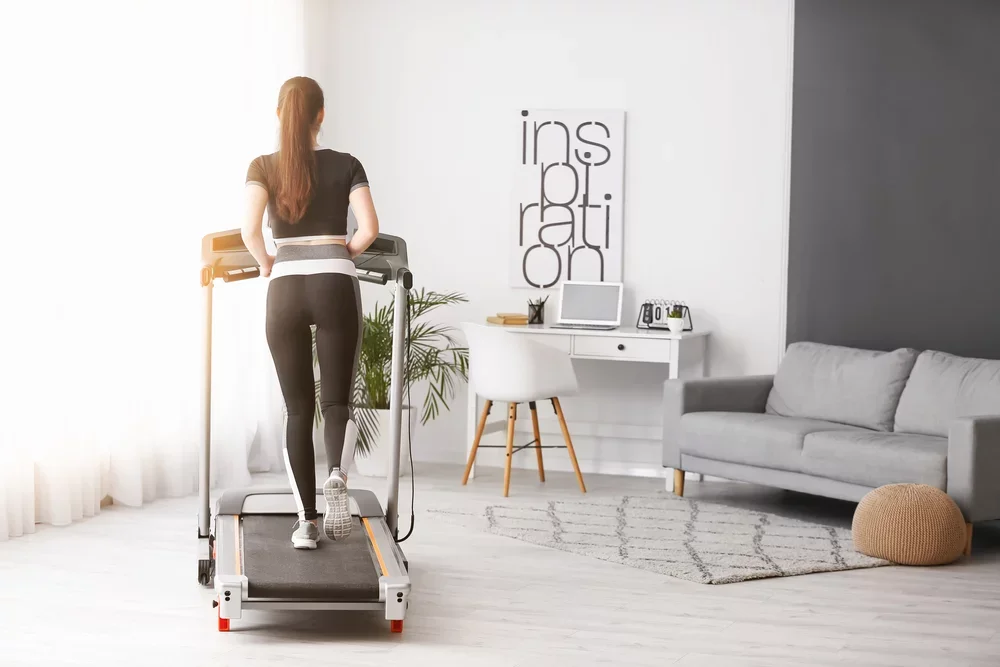
Best High-End Treadmills
Best for Larger/Heavier Users – Landice L8
Best for Marathon Training – Precor TRM 445
Best High-End Incline Trainer – NordicTrack X32i
How Treadmills Were Selected for This List
Every treadmill you’ll see in this list was researched, and, when possible, hand-tested to ensure you know exactly what to expect if you make a purchase. As a competitive athlete who has trained for everything from 5k’s to triathlons, marathons, and more, I’ve used dozens of treadmills over the years and know the ins and outs of what to look for.
In this roundup, I’ve considered premium features including motor size, incline/decline, speed, special programming options, warranty, and integrated technology. Each product is assessed without bias as some treadmills are simply better for certain types of training than others.
1. Best Overall – Life Fitness Club+
 |
|
The treadmills that made this list are premiere products ranging in price from $3,599 to $11,999. If you’re looking to make a notable investment in a treadmill that won’t break the bank yet still offer premium features including excellent build quality, diverse workout programming and entertainment options, and gym-quality design and technology, the Life Fitness Club+ treadmill is worth a look.
At a happy-medium cost relative to this list at $7,245, Life Fitness’s Club+ model provides a happy medium. Think Baby Bear’s porridge. It could be just right in balancing features and budget. Unlike some of the lower-cost products in this list, Club+ has you covered with a 4.0 CHP motor, above-average 400-lb. weight limit, and 15% incline to push the posterior leg muscles harder. While pricier products go above and beyond with more powerful motors and durability expectations, these are often only necessary for excessively high usage and/or body weight.
Although the Club+ treadmill isn’t foldable, it does include transport wheels for easier portability, and the 3.5” precision-crowned rollers found on the front and back ensure a good grip on the belt, which prevents damage and keeps your treadmill running smoothly. In addition to 22-built-in workouts, users can tap into thousands of workouts with unlimited access to targeted programming through Life Fitness’s partnership with Aaptiv.
Read all about the Life Fitness Club+ in my detailed review.
| Pros | Cons |
|---|---|
|
|
Key Specs
2. Best Budget-Friendly – Sole ST90
 |
|
When looking for a high-end treadmill, there are certain features you expect, and those features come at a higher cost. If you want a quality treadmill without spending $5,000+, there’s an argument to be made the Sole ST90 has the solution.
At first glance, it seems confusing this product comes in at $3,599, but the higher cost for a 2.5 CHP motor makes more sense when you understand its slat-belt design. Slat belts are more attuned to the natural gait of the human walk/run. Unlike a traditional belt supported by a deck, slat belts have less springs underneath, thus simulating a more realistic running surface while improving form and providing a softer landing surface.
True slat belt treadmills don’t have a motor, but this also means there’s no way to integrate tech like apps and built-in programming that designates speed. The ST90 can be described as a hybrid between traditional and slat technology. A newer product in the Sole lineup, the belt is flat, not slanted like a true slat tread. Despite these differences, the similarity is all in the compatibility with the natural human gait, which requires significantly less effort for the motor to support.
With that being understood, the Sole ST90 allows you to enjoy 29 built-in programs, Studio app integration, and screen-casting capabilities through the 10.1” touchscreen. This allows for science-based workout access while still enjoying slat-belt benefits. I had the opportunity to chat with customer service to answer some of my questions in better understanding how Sole’s version of this technology works and was surprised when I got a US-based representative in less than 30 seconds without having to go through a long, automated process.
See Brian’s in-depth review of the Sole ST90.
| Pros | Cons |
|---|---|
|
|
Key Specs
| Motor | 2.5 CHP |
|---|---|
| Incline | 0 — 15% |
| Running Area | 20″ x 60″ |
| Folding | No |
| Top Speed | 12.5 MPH |
| Weight Capacity | 330 LBS |
| Dimensions | 70″ L x 33.5″ W x 65″ H |
| Screen | 10.1” Touchscreen |
| Warranty | 5-Year Frame, 3-Year Parts, 1-Year Labor |
3. Best for Frequent Use and Aggressive Running – Freemotion T22.9
 |
|
If you frequently train at high speeds and/or max inclines, you put a lot of demand on the motor of your treadmill, and this should certainly be considered as you shop. Furthermore, people who carry a lot of weight, even when walking, need to consider investing in a product capable of the support required. Although it comes at the highest cost in this roundup, the Freemotion T22.9 can hold up to the test.
Most notably, it’s powered by a 5.0 continuous duty HP commercial drive motor. Unlike peak duty motors that can only maintain max speeds for short periods, continuous duty motors sustain longer high-speeds, are more durable, and provide a smoother running experience. To further support more aggressive training, roller consideration is important. These are the cylindrical pieces the track rolls around and the most commonly broken parts on a treadmill that typically range between 1.6” to 2.5”. The larger the diameter, the more durable, and the T22.9 ups the ante at 3.5”.
The support needed for heavy training is there, and so is the capability. Serious runners up to 400 lbs. can maintain speeds as high as 15 mph and 15% incline either through manual controls or iFit programming. All the while, the REFLEX™ proprietary cushioning absorbs the increased shock of heavy running to provide 52% increased tibial shock reduction than a flat running surface.
See Brian’s detailed review of the Freemotion T22.9.
| Pros | Cons |
|---|---|
|
|
Key Specs
| Motor | 5.0 CHP |
|---|---|
| Incline | 0 — 15% |
| Running Area | 21.5? x 60? |
| Folding | No |
| Top Speed | 15 MPH |
| Weight Capacity | 400 LBS |
| Dimensions | 87″ L x 30.0″ W x 86.3″ H |
| Screen | 22? HD Capacitive Touchscreen |
| Warranty | 7-Year Frame, 2-Year Parts, 1-Year Labor |
4. Best for Larger/Heavier Users – Landice L8
 |
|
If you carry a lot of weight, cheaper treadmills aren’t going to last as long. A $2,000 investment may not provide the longevity you expect, and it can make much more sense to make a heftier initial purchase that’ll provide more years of use. In fact, lighter use such as walking or jogging can place even more strain on the motor since slower speeds reduce the assistance your foot provides in pushing the belt back when running. Walking also increases the friction produced when your bodyweight is pushing down on the belt at slower speeds.
Regardless of how you use your treadmill, heavier folks need a sturdier motor and frame, and that’s exactly what you get with the Landice L8 treadmill. Its 1,000 pound thrust, 4.0 continuous duty drive motor is matched with a rust-free aluminum frame capable of supporting user weights of up to an industry-leading 500 lbs. With 22-lb. steel rollers measuring 3.5” in diameter, you can expect a better grip on the belt and less maintenance.
Unlike many treadmills, you can customize your investment based on your technological preferences with a choice in three consoles of varying degrees of tech capabilities. Although none of them feature app integration, the ability to add a VESA-D bracket able to support a monitor up to 19 inches to your order allows you to bring your own tech to the table. The consoles range in built-in programming options depending on your needs.
See my detailed review of the Landice L8.
| Pros | Cons |
|---|---|
|
|
Key Specs
| Motor | 4.0 CHP |
|---|---|
| Incline | 0 – 15% |
| Running Area | 22? x 63? |
| Folding | No |
| Top Speed | 12 MPH |
| Weight Capacity | 500 LBS |
| Dimensions | 83″ L x 35″ W x 61″ H |
| Screen | Depends on console chosen |
| Warranty | Lifetime Frame, Lifetime Parts, 1-Year Labor |
5. Best for Marathon Training – Precor TRM 445
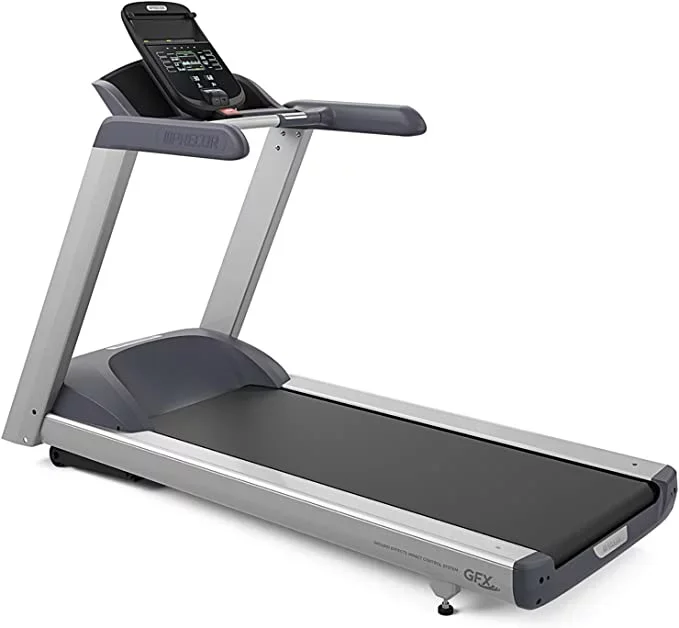 |
|
As someone who has trained for everything from sprints to marathons, I understand the type of training you must incorporate to achieve the best time. One of the worst things you can do is train in an unrealistic setting. For example, if you’re preparing to run the Rocky Mountain Half Marathon, training in Kansas wouldn’t build up the strength and endurance needed to sustain uphill stretches.
To allow for the most realistic training simulation, the Precor TRM 445 has aligned all the right features for long-distance training. For starters, you’re not paying extra for things like faster-than-normal top speed and a large running deck needed to support sprint training. The 12 mph max speed will suffice for long-distance training. Instead, Precor puts more of a focus on realistic terrain simulation, and its incline range of -2% to 15% allows preparation for both uphill and downhill conditions.
Precor’s integrated footplant technology works to control the speed of the belt to match your gait. To most accurately mimic running on a natural surface, the belt decelerates when your foot makes contact and speeds up when you push off. It’s also equipped with ground effects impact control that ensures the footplant is soft followed by a firm push-off to promote consistency in steady-state, long-distance running pattern while protecting your joints.
See Brian’s detailed review of the Precor TRM 445.
| Pros | Cons |
|---|---|
|
|
Key Specs
| Motor | 3.0 CHP |
|---|---|
| Incline | -2% – 15% |
| Running Area | 22″ x 56″ |
| Folding | No |
| Top Speed | 12 MPH |
| Weight Capacity | 300 LBS |
| Dimensions | 79″ L x 34″ W x 59″ H |
| Screen | 7″ LCD Touchscreen |
| Warranty | Lifetime Frame, 10-Year Parts, 1-Year Labor |
6. Best High-End Incline Trainer – NordicTrack X32i
 |
|
When you drive your car uphill, you have to push harder on the accelerator to maintain your speed. Conversely, you must push on the brake when you go downhill. The steeper the hill, the more exaggerated these actions become. Just like your car must work harder driving on uneven terrain, your body works harder on an incline and decline. To take the analogy further, uphill driving burns more gas like incline and decline training torches more calories.
When steeper matters, NordicTrack’s Commerical X32i treadmill has you covered with an industry-leading 40% incline. Research suggests that, for every 1% incline, someone weighing 150 lbs. will burn around 10 more calories per mile. At 40% incline, a five-mile walk would torch an additional 200 calories in additional to what you’d burn on a flat surface.
When you’re using a treadmill, you’re thinking cardio, but incline training gives you a unique opportunity to kill two birds with one stone by incorporating lower body strength training into the mix. The incline training works the posterior muscles like the glutes, hamstrings, and calves. Then, when you take advantage of -6% decline training, muscle recruitment switches to a focus on anterior muscles like the quads and hip flexors. Best of all, the remote trainer controls through integrated iFit programming on the large touchscreen can help you train on some of the most scenic hilly terrain around the world.
See my detailed review of the NordicTrack X32i.
| Pros | Cons |
|---|---|
|
|
Key Specs
| Motor | 4.25 CHP |
|---|---|
| Incline | -6 — 44% |
| Running Area | 22” x 60” |
| Folding | No |
| Top Speed | 12 MPH |
| Weight Capacity | 300 LBS |
| Dimensions | 76.5″ L x 40″ W x 73″ H |
| Screen | 32” HD Touchscreen |
| Warranty | 10-Year Frame, 2-Year Parts, 1-Year Labor |
Want to compare these models to see which one is best for you? Try our comparison tool. To use it, just check off any treadmill you want to look at in more detail, and then click ‘compare’. Learn more about what to look for when shopping for a new home treadmill below.
What to Look for When Shopping for a High-End Treadmill
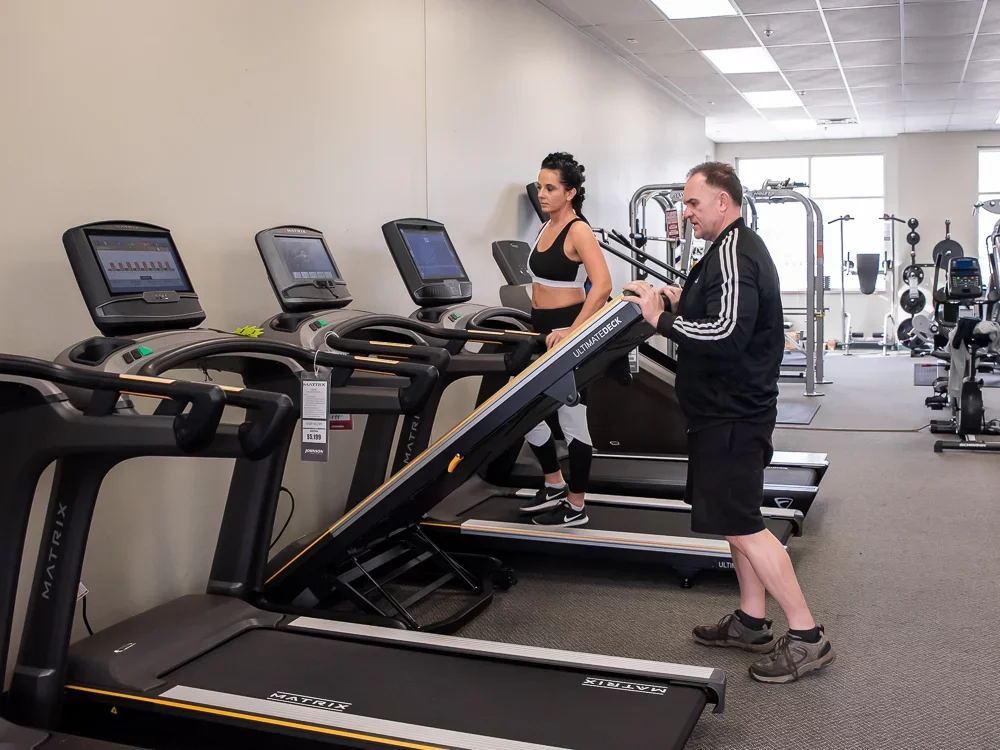
Brian and I have travelled across the country to assess some of the most popular high-end treadmills on the market. Photo by: Oleksandr Kosheliev / TreadmilReviews.net
How Treadmill Specs Relate to Your Needs
Treadmill specs can be confusing, and we’re here to walk you through the weeds. That’s why we offer helpful information like our comprehensive treadmill buyer’s guide. When it comes to features specific to high-end products, let’s break down what you should expect and look for at a premium price.
Keep in mind, as you assess the buying points we’re about to examine, they’re relative to your budget and needs. While some may score high in one category, they may not excel in others. That has been the purpose of breaking down the products based on need in the roundup above.
Understanding Treadmill Motor Power
When assessing a treadmill motor, you’ll see a number followed by an acronym, and it’s important to understand what each means. A high-end treadmill tends to offer a premium motor, so let’s see what that looks like.
Horsepower
Horsepower measures an engine’s ability to accelerate, but it’s not literally the power of a horse. The term was coined in the late 1700’s to describe the energy required for a horse to raise a 33,000 pounds suspended into a 1,000 foot deep hole one foot off the ground in one minute. Yes, that’s a mouthful to say and even more difficult to picture. Today, a dynamometer is used to make the calculation more consistent and measurable.
In premiere treadmills, it’s typical to see 3.0 to 4.0 horsepower with the average for this roundup weighing in at 3.79. The lower end of this spectrum is usually adequate for jogging and running for people of average height and weight. Motors of 4.0+ horsepower are for more serious running at fast speeds and/or max inclines. They can also perform more effectively for those who carry a lot of weight.
Continuous Duty vs. Peak Duty
It can be easy to gloss over the acronym that follows the horsepower rating, but it matters. Most commonly you will see HP and CHP, so let’s break it down so you understand the quality of each:
- HP- Measurement of peak performance that strictly assesses motor’s top power without regard to performance over time
- CHP- Considers motor’s ability to maintain power for prolonged periods of time
As you shop, pay attention to inexpensive treadmills with high horsepower ratings. Often, they’re followed with the acronym “HP”. All treadmill motors in this roundup are measured using continuous horsepower standards.
Speed and Incline
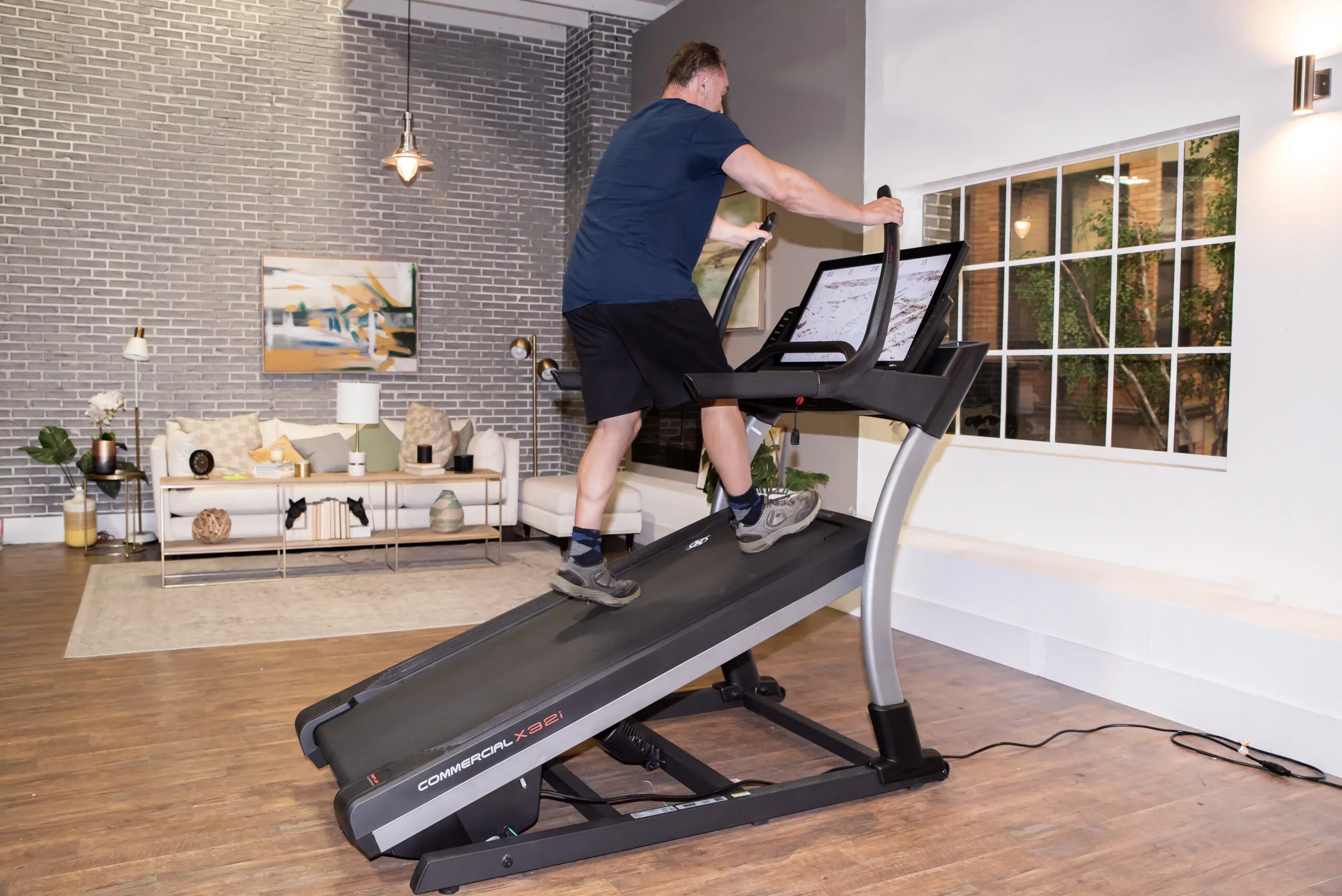
TreadmillReviews editor Brian Boyce maxes out a 40% incline during visit to iFit showroom in Logan, Utah. You can clearly see why the NordicTrack X32i is our top pick for high-end incline trainer. Photo by: Oleksandr Kosheliev / TreadmilReviews.net
Most high-end treadmills max out at a top speed of 12 mph. The average top sprinting speed amongst athletes, male and female, is around 18 mph, but these speeds typically cannot be maintained for longer than 20-30 seconds. It’s not typical for people to train at such an elite level, and our top speed in this roundup is found in the Freemotion T22.9 at 15 mph with a $11,999 price tag.
Don’t have the budget to spend that much? Not to worry. Adding incline and decline training to the mix can significantly increase caloric burn while toning lower body muscles. Lower-budget treadmills often peak out at 10% incline with no decline option. Extending your budget to the high-end caliber should get you at least 15% as is the minimum found in this roundup with declines as much as -6% and top incline of 40% with the NordicTrack X32i.
Running Area and Your Training Style
Chances are, if you’re in the market for a premium treadmill, you’re going to be using it for running, sometimes at fast speeds. This type of training requires a larger running belt, and that’s what you get with pricier products. There are three typical running areas you’ll see as you shop, so let’s take a look at each along and their capabilities.
- 20”×55” – Supports walking and light jogging for people under 6’ tall
- 20”×60” – Industry standard for walking, jogging, and running
- 22”×60” – Great for tall runner and those who run at fast speed and/or incline/decline
Customization
Customization is often available on high-end treadmills but still rare at lower price points. One area for customization is the console. Several manufacturers make up to four consoles available for each high-end treadmill model. The consoles have different workout programming, screen sizes, and entertainment options. This allows every customer to get features they want without paying for perks that aren’t of interest. Other examples of treadmill customization are:
- Frame Color: Customers of Cybex International can choose virtually any frame color for their fitness equipment.
- Speed: High-end treadmills often exceed the industry standard top speed of 12 mph. Sometimes this high speed is standard, while other times it is offered as an upgrade.
- Hospital-Grade Wiring: High-end treadmills are often required for use in physical therapy clinics and other medical settings, so a few brands like Landice offer the option of hospital-grade wiring.
Premium Treadmill Electronics
The best high-end treadmills show off the industry’s latest and greatest electronics. Our favorite brands made the switch from standard LED or LCD consoles to touchscreens. These full-color screens have controls for workouts and mobile devices, and some can play high definition video (workouts, movies, etc.). Because many of these treadmills are built for club use, they have special features not found on residential treadmills including:
- Wireless connectivity for downloading new workouts
- Wireless connectivity for tracking workout stats
- Interactive video workouts
- Live or on-demand TV programming
- Built-in web browser
- Choice of languages
- Multiple user profiles
Like cheaper alternatives, high-end treadmills also have speakers and secure docks for mobile devices.
Warranty
One of the major selling points for high-end treadmills are their generous warranties. When comparing warranties for the best treadmills at different price points, you can see that, while high-end treadmills cost more up front, they will sometimes cost the same or less per day in the long run. At the same time, trainees will benefit from far superior workout experiences, and owners will appreciate the low maintenance requirements. Customer-friendly warranties are made possible by components such as high-quality wiring, self-cooling motors, large track rollers, and thick belts. Here are rough guidelines for warranties on the best luxury treadmills:
- Frame, Motor and Deck: Lifetime coverage
- Parts: Five to ten years
- Electronics: Two to five years
- Labor: Two or three years
Note that many high-end treadmills are sold with two or more warranty packages: residential, light commercial and full commercial. Coverage is most extensive for residential treadmills.
Best Luxury Treadmill: Final Thoughts
While cheap treadmills might only have parts protection for one year, high-end treadmills sometimes have 10 years of free parts replacement. That’s because these machine rarely ever break down even over the long haul. From deck to console, the best high-end treadmills are commercial quality. They’ll meet the heavy demands of fitness clubs and serve a lifetime in home gyms.
The best luxury treadmills outpace the alternatives in almost every way. Excellent construction and electronics justify their above-average prices and allow the manufacturers to include generous warranties. Read our in-depth treadmill reviews to learn more about specific models mentioned above.
Additional Treadmill Resources
- How to Fix Common Treadmill Problems
- Treadmill Motors: What You Need to Know
- List of Treadmill Brands
- List of Treadmills
- Treadmil Buyer’s Guide
- History of The Treadmill
Recent Updates
December 1, 2022: Added photos from personal use. Updated specs. Added products to the list and assigned awards to each. Expanded buyer’s guide information. Added a FAQ section.
Frequently Asked Questions
Is it worth it to buy an expensive treadmill?
If you train high speeds, max incline/decline, or with consistently high frequency, it can be worth the investment in a treadmill that'll stand the test of time.
What makes a treadmill more expensive?
High-end treadmills offer higher horsepower, broader max speeds and incline/decline, premium weight capacities, improved electronics packages, and strong build quality.
How much should I pay for a good treadmill?
While it depends on your needs, those requiring a premium product should expect to pay between $4,000-$12,000+ depending on personal needs and preferences.
What size motor should I look for in a high-end treadmill?
High-end treadmills typically feature motors with a horsepower rating between 3.0 to 4.0. Look for CHP as this indicates it's max speed was tested for a prolonged time period.
Do treadmills need maintenance?
While some high-end treadmills offer advanced features that minimize the need for maintenance, most will require regular lubing and cleaning. Always refer to the owner's manual for specific requirements for maximum durability.
Other Treadmill Reviews:
- Amazon Big Spring Sale 2025 for Treadmills
- About: Brian Boyce
- Best Treadmills for Home
- Test HomePage
- NordicTrack Commercial X14i
- Echelon Stride
- NordicTrack C 590 Pro
- Sole TD80 Treadmill Desk
- NordicTrack Commercial X11i
- NordicTrack T 8.5 S - Pros & Cons (2025)
- Horizon Elite T5
- ProForm Pro 1000
- Exerpeutic TF1000
- NordicTrack T 6.5 S - Pros & Cons (2025)
- ProForm Sport 5.0
- ProForm Premier 900
- ProForm ZT6
- NordicTrack FreeStride Trainer FS5i (Discontinued)
- Bowflex Max Trainer M5
- BowFlex TreadClimber TC100
- ProForm Power 795
- ProForm Sport 7.0
- NordicTrack Incline Trainer X15i
- LifeSpan TR3000e Electric Folding
- NordicTrack C 1650 Treadmill
- Horizon Elite T9
- Official Boston Marathon Treadmill 4.0
- NordicTrack Treadmill Desk
- NordicTrack C 1630 Pro
- NordicTrack C 970 PRO
- Bowflex TC20 TreadClimber

 $7,245
$7,245  $3,599
$3,599  $11,999
$11,999  $6,299
$6,299 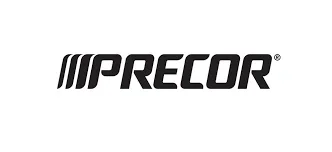 $4,199
$4,199  $4,999
$4,999 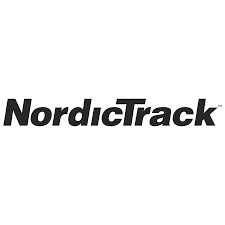 $4,499
$4,499